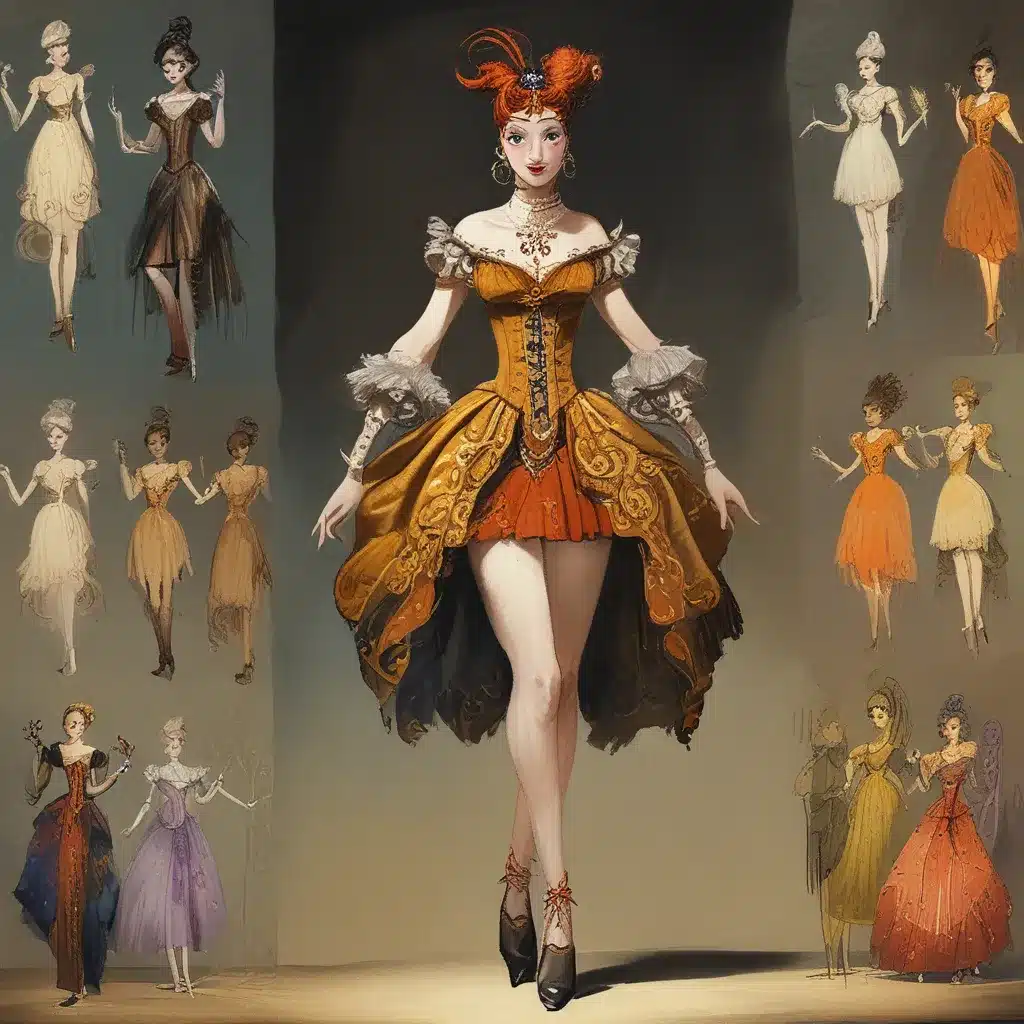
As I sit here in my cozy studio, surrounded by bolts of fabric, sketches, and inspiration boards, I can’t help but feel a sense of excitement at the prospect of diving into the world of costume design for the musical stage. It’s a realm where clothing and character collide, where the right fabric, cut, and color can transform a performer into a living, breathing embodiment of a story.
Growing up, I was always fascinated by the power of fashion to evoke emotion and convey meaning. I would spend hours poring over the costumes in my favorite stage productions, marveling at how a simple change in silhouette or the addition of a subtle embellishment could so profoundly impact the way a character was perceived. Now, as a costume designer myself, I have the privilege of being the one who wields that magic.
The Art of Transformation
Costume design is a crucial aspect of theatre that contributes significantly to the overall experience of watching a performance. It’s not just about creating visually appealing outfits; it’s about using clothing as a means of storytelling, a way to delve deeper into the hearts and minds of the characters we see on stage.
“The right costume can bring a character to life, allowing the audience to connect with and understand them better,” as the article on costume design for Fun Home so eloquently states. By paying attention to every detail, from fabric choice to color and style, costume designers help create a more immersive and engaging experience for the audience.
And what better place to witness this transformative power than on the musical stage, where the characters we love come alive through song, dance, and, of course, their carefully crafted costumes? It’s a world where I get to channel my inner Dr. Frankenstein, stitching together the perfect sartorial pieces to bring a character to life.
Revealing the Character’s Story
When I approach a new musical project, I don’t just start sketching designs. No, I first immerse myself in the script, the score, and the characters themselves, trying to understand their motivations, their struggles, and their dreams. It’s only then that I can begin to craft the outfits that will help bring their stories to the stage.
Take, for example, the character of Mary Bennet from the musical MISS BENNET: CHRISTMAS AT PEMBERLEY. On the surface, she might seem like the prim and proper middle sister, content to fade into the background. But as I delved into the script, I discovered a young woman yearning for independence and the chance to define herself beyond her family’s expectations.
With that insight, I knew her costumes needed to reflect a sense of transformation – a shedding of the staid, conservative dresses of her youth in favor of garments that allowed her to express her emerging sense of self. Perhaps a rich, jewel-toned gown with a touch of whimsy, or a smart, tailored pantsuit that hinted at her newfound confidence.
It’s these little details, these subtle shifts in silhouette and color, that can make all the difference in how a character is perceived and understood by the audience. And that’s the true magic of costume design – the ability to weave a character’s inner journey into the very fabric of their outward appearance.
Drawing Inspiration from the Unexpected
Of course, bringing a character to life on the musical stage isn’t just about the costumes themselves. It’s also about tapping into the unexpected sources of inspiration that can breathe new life into a design.
As Noah Hynick, who plays Ollie in RADIANT VERMIN, shared, “I’m a real Dr. Frankenstein when it comes to character inspiration. I might use a character or two, I might find a painting or a poem that I think makes a connection. I’m most affected by taste and smell, so that comes into play a lot.”
It’s that kind of open-minded, curious approach to finding inspiration that I try to emulate in my own work. I might stumble upon an obscure 19th-century portrait that sparks an idea for a character’s silhouette, or discover a vintage fashion magazine that leads me to a bold color palette. Sometimes, it’s even the most unexpected sensory experiences – the taste of a particular spice or the scent of a blooming flower – that can ignite the creative spark.
And let’s not forget the power of collaboration. Working alongside the director, choreographer, and other members of the creative team is crucial in bringing a musical’s visual identity to life. It’s through these dynamic exchanges of ideas and perspectives that we can push the boundaries of what’s possible, crafting costumes that not only serve the characters but also elevate the overall storytelling.
The Endless Possibilities of the Musical Stage
As I gaze around my studio, surrounded by swatches, sketches, and the occasional glittering sequin, I can’t help but feel a sense of awe at the sheer potential of the musical stage. It’s a canvas upon which we, as costume designers, can paint the most vibrant, imaginative, and transformative visions.
Whether it’s the dazzling, almost otherworldly costumes of a musical theater education and performance center, or the gritty, lived-in garments of a grounded, character-driven show, the possibilities are truly endless. And with each new project, each new set of characters to bring to life, I’m filled with a sense of excitement and possibility.
After all, what could be more thrilling than the opportunity to take an audience on a journey, to transport them to a world of wonder and magic through the power of costume design? It’s a responsibility I don’t take lightly, but it’s one that fills me with a deep sense of purpose and joy.
So, as I continue to craft the sartorial dreams that will grace the musical stage, I know that I’m not just designing costumes – I’m helping to create moments of pure theatrical enchantment. And that, my friends, is the true magic of this art form.

